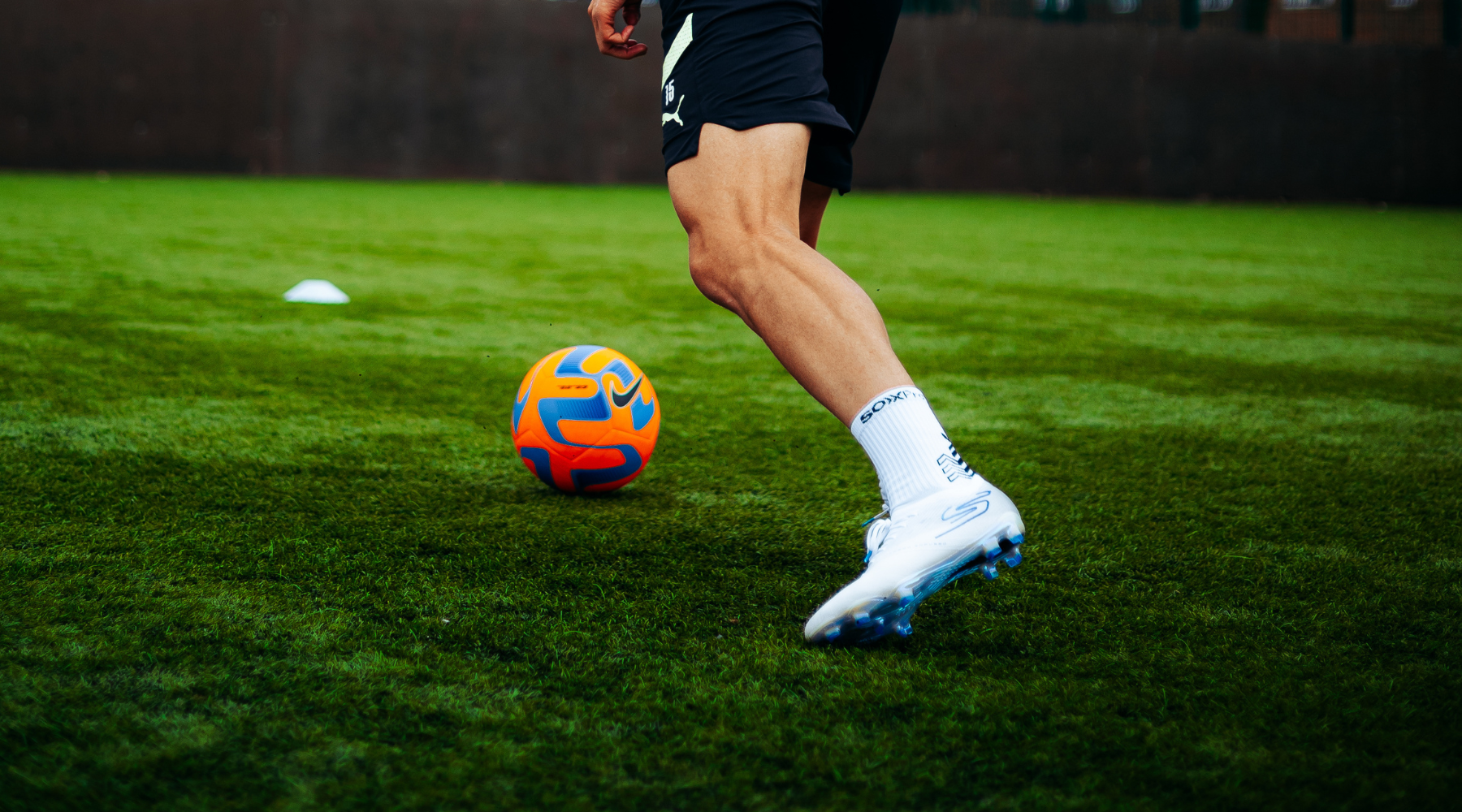Bei einem Fußballspiel können Millisekunden über Sieg und Niederlage entscheiden; Chancen kommen und gehen im Handumdrehen. Spieler, die ihre Geschwindigkeit kultivieren, werden von den Gegnern gefürchtet, während langsamere Spieler oft ineffektiv sind und möglicherweise den Ball verlieren.
Ob es ein Verteidiger ist, der den Lauf eines Stürmers verfolgt, ein Flügelspieler, der versucht, seinen Mann zu schlagen, oder ein Mittelfeldspieler, der Boden zurücklegt, um einen Pass abzufangen, Geschwindigkeit ist der Schlüssel zur Fußballleistung.
Zu lange wurde Geschwindigkeit als eine inhärente Eigenschaft angesehen und nicht als etwas, das man durch Übung entwickeln kann; Dies könnte jedoch nicht weiter von der Wahrheit entfernt sein.
Obwohl Schnelligkeit zum Teil auf ererbte Merkmale zurückzuführen ist, beispielsweise auf einen höheren Anteil an Typ-IIb-Muskelfasern, bleibt es trotz dieses minimalen genetischen Beitrags eine Fähigkeit, die Spieler entwickeln können und müssen, um ihre Leistung auf dem Spielfeld zu verbessern. Die Wissenschaft hat bewiesen, dass Sie durch Training die Architektur Ihrer Muskeln verändern, Ihre Biomechanik verbessern und die neuromuskuläre Koordination verbessern können, was Sie mit jedem Schritt nach vorne katapultiert.
Da das moderne Spiel immer schneller wird, sind immer mehr Studien entstanden, die die besten Möglichkeiten aufzeigen, die Geschwindigkeit auf dem Spielfeld zu verbessern. Das Problem ist, dass Fußball nicht so einfach ist wie das Laufen in einer geraden Linie. Viel zu lange nutzen Spieler veraltete Trainingstechniken, die für andere Sportarten entwickelt wurden, in der Hoffnung, auf dem Spielfeld schneller zu werden. Ich hatte das Glück, mit Spielern zusammenzuarbeiten, die ihr Handwerk in den Top-Ligen der Welt ausüben, etwa in der Premier League, der Serie A und der Champions League. Bei der Arbeit mit Elite-Profifußballspielern wird schnell klar, dass die schnellsten Spieler in einer geraden Linie nicht immer diejenigen sind, die im Spiel als Erster an den Ball kommen. Das liegt daran, dass es beim geradlinigen Sprinten an Kontext mangelt und Fußball weitaus komplexer ist.
Das Training, schnell auf einer Geraden zu sein, ist unzureichend; Auf dem Platz schnell zu werden, ist nicht so einfach wie das Training für einen 100-m-Sprint. Betrachten Sie die zuvor genannten Beispiele: Es könnte sich um einen schnellen Tempowechsel, einen Geschwindigkeitsschub oder einen Spieler handeln, der über das Ziel hinaus beschleunigt. Geschwindigkeit wird auf dem Spielfeld auf unterschiedliche Weise genutzt. Es ist nicht unbedingt Ihre Höchstgeschwindigkeit, die Sie ausmacht, sondern vielmehr, wie schnell Sie Ihr Ziel erreichen – alles hängt von der Zeit ab. Der Schlüssel ist die Geschwindigkeitsänderungsrate oder Beschleunigung. Wenn man sich beeilt, vor einem Gegner an den Ball zu kommen, wird der Spieler, der seine Höchstgeschwindigkeit schneller erreichen kann, wahrscheinlich das Wettrennen gewinnen, auch wenn der Gegner eine höhere Höchstgeschwindigkeit hat.
Die Lösung für veraltete, kontextlose Trainingstechniken ist Beschleunigungstraining, das sich auf die Entwicklung explosiver konzentrischer Muskelkontraktionen konzentriert, die jeden Schritt vorantreiben. Dies ermöglicht es den Spielern, schneller die Höchstgeschwindigkeit zu erreichen und schnell auf plötzliche Spielveränderungen zu reagieren.
Zu Ihrem Glück haben wir die Recherche gesichtet und drei Übungen ausgewählt, die einige der neuesten Trainingskonzepte ans Licht bringen. Diese Übungen verbessern Ihre Fähigkeit, sich vom Verteidiger zu lösen, indem sie die explosiv-konzentrische Muskelkontraktion trainieren, die für diesen Geschwindigkeitsschub verantwortlich ist. Wenn Sie diese Übungen häufig genug ausführen, entwickeln Sie die erforderliche Explosivität, um Ihren Mann zu beschleunigen und Sie als Erster zum Ball zu bringen.
Übung 1: Beinschalter
Beginnen Sie im Ausfallschritt, mit einem Fuß nach vorne und dem anderen hinter Ihnen. Senken Sie Ihren Körper, indem Sie Ihre Hüften und Knie beugen. Verlagern Sie Ihr Gewicht auf die Zehen, sodass die Ferse Ihres Vorderfußes knapp über dem Boden schwebt. Während Sie in dieser niedrigen Position bleiben, wechseln Sie schnell Ihre Beine in einer Scherenbewegung. Legen Sie die Landung auf den Vorderfuß, halten Sie das Gleichgewicht und wiederholen Sie den Vorgang. Zwischen den Wiederholungen kann es eine Pause geben, aber der Wechsel muss immer explosiv sein. Wiederholen Sie dies für 12 Schalter und führen Sie 3 Sätze durch.
Übung 2: Seitliche Begrenzungen
Beginnen Sie, aufrecht auf den Zehenspitzen zu stehen. Lassen Sie sich fallen und stoßen Sie Ihr äußeres Bein ab, um so weit wie möglich zur Seite zu springen. Befestigen Sie die Landung mit dem anderen Bein. Auf der anderen Seite wiederholen. Führen Sie 12 Wiederholungen für 3 Sätze durch.
Übung 3: Kniender Sprinter startet
Beginnen Sie auf einem Knie und verlagern Sie Ihr Gewicht auf Ihr Vorderbein. Drücken Sie das Vorderbein kräftig in den Boden, um hochzuspringen. Schwingen Sie beim Springen Ihr hinteres Bein nach vorne und heben Sie Ihr Knie an – das wird Ihnen helfen, höher zu springen. Wiederholen Sie dies für 6 Sprünge und wechseln Sie dann die Seiten. Absolvieren Sie insgesamt 3 Sätze pro Bein.
Für viele Spieler ist es eine Herausforderung, auf dem Spielfeld mithalten zu können, was oft auf veraltete Trainingsroutinen und den Mythos zurückzuführen ist, dass Geschwindigkeit einfach angeboren ist. Aber die Wissenschaft sagt uns etwas anderes. Der Schlüssel, um dort schneller zu werden, wo es darauf ankommt, liegt in der Trainingsbeschleunigung: der explosiven, schnell einsetzenden Muskelkraft, die Sie aus der Bahn wirft und Ihnen einen Geschwindigkeitsvorsprung verschafft. Indem Spieler diese Fähigkeit im Laufe der Zeit verfeinern, können sie eine wirklich bahnbrechende Geschwindigkeit aufbauen und ihr rohes Potenzial jedes Mal, wenn sie das Spielfeld betreten, in echte Ergebnisse umwandeln.










